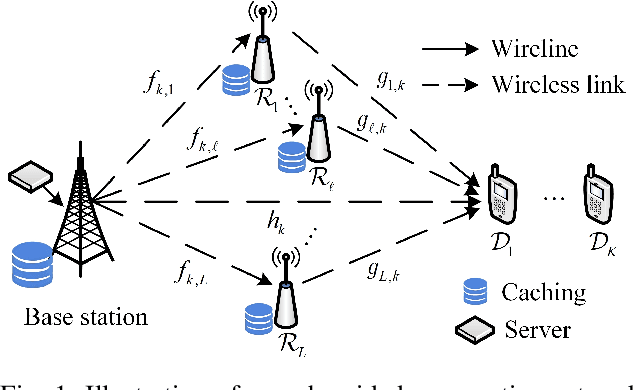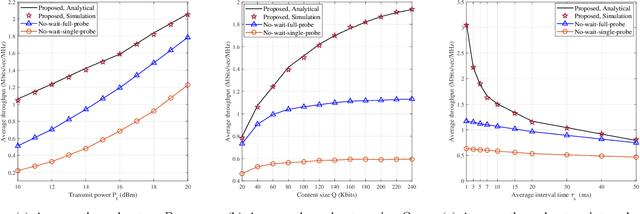Saman Atapattu
Performance Analysis for Multi-User Holographic MIMO Downlink with Matched Filter Precoding
Oct 06, 2025Abstract:Holographic MIMO (HMIMO) has emerged as a promising solution for future wireless systems by enabling ultra-dense, spatially continuous antenna deployments. While prior studies have primarily focused on electromagnetic (EM) modeling or simulation-based performance analysis, a rigorous communication-theoretic framework remains largely unexplored. This paper presents the first analytical performance study of a multi-user HMIMO downlink system with matched filter (MF) precoding - a low-complexity baseline scheme. By incorporating multipath propagation, mutual coupling, and element excitation, we derive a novel closed-form expression for the MF signal-to-interference-plus-noise ratio (SINR) using an equivalent random variable model. Leveraging bivariate gamma distributions, we then develop tractable throughput approximations under full, partial, and no channel state information (CSI) scenarios. Additionally, we formulate a max-min beamforming problem to benchmark optimal user fairness performance. Numerical results validate the accuracy of the proposed framework and reveal that MF precoding achieves competitive performance with strong robustness to low SINR and CSI uncertainty.
Joint Probing and Scheduling for Cache-Aided Hybrid Satellite-Terrestrial Networks
Oct 06, 2025Abstract:Caching is crucial in hybrid satellite-terrestrial networks to reduce latency, optimize throughput, and improve data availability by storing frequently accessed content closer to users, especially in bandwidth-limited satellite systems, requiring strategic Medium Access Control (MAC) layer. This paper addresses throughput optimization in satellite-terrestrial integrated networks through opportunistic cooperative caching. We propose a joint probing and scheduling strategy to enhance content retrieval efficiency. The strategy leverages the LEO satellite to probe satellite-to-ground links and cache states of multiple cooperative terrestrial stations, enabling dynamic user scheduling for content delivery. Using an optimal stopping theoretic approach with two levels of incomplete information, we make real-time decisions on satellite-terrestrial hybrid links and caching probing. Our threshold-based strategy optimizes probing and scheduling, significantly improving average system throughput by exploiting cooperative caching, satellite-terrestrial link transmission, and time diversity from dynamic user requests. Simulation results validate the effectiveness and practicality of the proposed strategies.
Null-Shaping for Interference Mitigation in LEO Satellites Under Location Uncertainty
Oct 01, 2025Abstract:Radio frequency interference (RFI) poses a growing challenge to satellite communications, particularly in uplink channels of Low Earth Orbit (LEO) systems, due to increasing spectrum congestion and uncertainty in the location of terrestrial interferers. This paper addresses the impact of RFI source position uncertainty on beamforming-based interference mitigation. First, we analytically characterize how geographic uncertainty in RFI location translates into angular deviation as observed from the satellite. Building on this, we propose a robust null-shaping framework to increase resilience in the communication links by incorporating the probability density function (PDF) of the RFI location uncertainty into the beamforming design via stochastic optimization. This allows adaptive shaping of the antenna array's nulling pattern to enhance interference suppression under uncertainty. Extensive Monte Carlo simulations, incorporating realistic satellite orbital dynamics and various RFI scenarios, demonstrate that the proposed approach achieves significantly improved mitigation performance compared to conventional deterministic designs.
Dynamic Scheduling for Enhanced Performance in RIS-assisted Cooperative Network with Interference
Jun 15, 2025Abstract:Reconfigurable Intelligent Surfaces (RIS) have emerged as transformative technologies, enhancing spectral efficiency and improving interference management in multi-user cooperative communications. This paper investigates the integration of RIS with Flexible-Duplex (FlexD) communication, featuring dynamic scheduling capabilities, to mitigate unintended external interference in multi-user wireless networks. By leveraging the reconfigurability of RIS and dynamic scheduling, we propose a user-pair selection scheme to maximize system throughput when full channel state information (CSI) of interference is unavailable. We develop a mathematical framework to evaluate the throughput outage probability when RIS introduces spatial correlation. The derived analytical results are used for asymptotic analysis, providing insights into dynamic user scheduling under interference based on statistical channel knowledge. Finally, we compare FlexD with traditional Full Duplex (FD) and Half Duplex (HD) systems against RIS-assisted FlexD. Our results show FlexD's superior throughput enhancement, energy efficiency and data management capability in interference-affected networks, typical in current and next-generation cooperative wireless applications like cellular and vehicular communications.
Eigenvalue-Based Detection in MIMO Systems for Integrated Sensing and Communication
Jun 11, 2025Abstract:This paper considers a MIMO Integrated Sensing and Communication (ISAC) system, where a base station simultaneously serves a MIMO communication user and a remote MIMO sensing receiver, without channel state information (CSI) at the transmitter. Existing MIMO ISAC literature often prioritizes communication rate or detection probability, typically under constant false-alarm rate (CFAR) assumptions, without jointly analyzing detection reliability and communication constraints. To address this gap, we adopt an eigenvalue-based detector for robust sensing and use a performance metric, the total detection error, that jointly captures false-alarm and missed-detection probabilities. We derive novel closed-form expressions for both probabilities under the eigenvalue detector, enabling rigorous sensing analysis. Using these expressions, we formulate and solve a joint power allocation and threshold optimization problem that minimizes total detection error while meeting a minimum communication rate requirement. Simulation results demonstrate that the proposed joint design substantially outperforms conventional CFAR-based schemes, highlighting the benefits of power- and threshold-aware optimization in MIMO ISAC systems.
Uniform Planar Array Based Weighted Cooperative Spectrum Sensing for Cognitive Radio Networks
Apr 14, 2025Abstract:Cooperative spectrum sensing (CSS) is essential for improving the spectrum efficiency and reliability of cognitive radio applications. Next-generation wireless communication networks increasingly employ uniform planar arrays (UPA) due to their ability to steer beamformers towards desired directions, mitigating interference and eavesdropping. However, the application of UPA-based CSS in cognitive radio remains largely unexplored. This paper proposes a multi-beam UPA-based weighted CSS (WCSS) framework to enhance detection reliability, applicable to various cognitive radio networks, including cellular, vehicular, and satellite communications. We first propose a weighting factor for commonly used energy detection (ED) and eigenvalue detection (EVD) techniques, based on the spatial variation of signal strengths resulting from UPA antenna beamforming. We then analytically characterize the performance of both weighted ED and weighted EVD by deriving closed-form expressions for false alarm and detection probabilities. Our numerical results, considering both static and dynamic user behaviors, demonstrate the superiority of WCSS in enhancing sensing performance compared to uniformly weighted detectors.
Opportunistic Beamforming and Dynamic Scheduling for Multi-User MIMO-ISAC Systems
Apr 06, 2025Abstract:This research presents a novel framework integrating Flexible-Duplex (FlexD) and Integrated Sensing and Communications (ISAC) technologies to address the challenges of spectrum efficiency and resource optimization in next-generation wireless networks. We develop a unified system model for a dual-functional radar-communication base station with multiple-input multiple-output capabilities, enabling dynamic uplink and downlink channel allocation. The framework maximizes network throughput while maintaining radar sensing performance, subject to signal-to-clutter-plus-noise ratio (SCNR) requirements and power constraints. Given the non-convex and combinatorial nature of the resulting optimization problem, we propose an iterative algorithm that converges to a locally optimal solution. Extensive simulations demonstrate the superiority of the proposed FlexD-ISAC framework compared to conventional half-duplex networks. Additionally, sensitivity analyses reveal the impact of SCNR requirements and power constraints on system performance, providing valuable insights for practical implementation. This work establishes a foundation for future research in dynamic, resource-efficient wireless systems that simultaneously support sensing and communication capabilities.
Detection of Signals in Colored Noise: Roy's Largest Root Test for Non-central $F$-matrices
Nov 27, 2024



Abstract:This paper investigates the signal detection problem in colored noise with an unknown covariance matrix. In particular, we focus on detecting a non-random signal by capitalizing on the leading eigenvalue (a.k.a. Roy's largest root) of the whitened sample covariance matrix as the test statistic. To this end, the whitened sample covariance matrix is constructed via \(m\)-dimensional \(p \) plausible signal-bearing samples and \(m\)-dimensional \(n \) noise-only samples. Since the signal is non-random, the whitened sample covariance matrix turns out to have a {\it non-central} \(F\)-distribution with a rank-one non-centrality parameter. Therefore, the performance of the test entails the statistical characterization of the leading eigenvalue of the non-central \(F\)-matrix, which we address by deriving its cumulative distribution function (c.d.f.) in closed-form by leveraging the powerful orthogonal polynomial approach in random matrix theory. This new c.d.f. has been instrumental in analyzing the receiver operating characteristic (ROC) of the detector. We also extend our analysis into the high dimensional regime in which \(m,n\), and \(p\) diverge such that \(m/n\) and \(m/p\) remain fixed. It turns out that, when \(m=n\) and fixed, the power of the test improves if the signal-to-noise ratio (SNR) is of at least \(O(p)\), whereas the corresponding SNR in the high dimensional regime is of at least \(O(p^2)\). Nevertheless, more intriguingly, for \(m<n\) with the SNR of order \(O(p)\), the leading eigenvalue does not have power to detect {\it weak} signals in the high dimensional regime.
Signal Detection in Colored Noise Using the Condition Number of $F$-Matrices
Nov 26, 2024


Abstract:Signal detection in colored noise with an unknown covariance matrix has numerous applications across various scientific and engineering disciplines. The analysis focuses on the square of the condition number \(\kappa^2(\cdot)\), defined as the ratio of the largest to smallest eigenvalue \((\lambda_{\text{max}}/\lambda_{\text{min}})\) of the whitened sample covariance matrix \(\bm{\widehat{\Psi}}\), constructed from \(p\) signal-plus-noise samples and \(n\) noise-only samples, both \(m\)-dimensional. This statistic is denoted as \(\kappa^2(\bm{\widehat{\Psi}})\). A finite-dimensional characterization of the false alarm probability for this statistic under the null and alternative hypotheses has been an open problem. Therefore, in this work, we address this by deriving the cumulative distribution function (c.d.f.) of \(\kappa^2(\bm{\widehat{\Psi}})\) using the powerful orthogonal polynomial approach in random matrix theory. These c.d.f. expressions have been used to statistically characterize the performance of \(\kappa^2(\bm{\widehat{\Psi}})\).
Throughput Optimization in Cache-aided Networks: An Opportunistic Probing and Scheduling Approach
Sep 02, 2024

Abstract:This paper addresses the challenges of throughput optimization in wireless cache-aided cooperative networks. We propose an opportunistic cooperative probing and scheduling strategy for efficient content delivery. The strategy involves the base station probing the relaying channels and cache states of multiple cooperative nodes, thereby enabling opportunistic user scheduling for content delivery. Leveraging the theory of Sequentially Planned Decision (SPD) optimization, we dynamically formulate decisions on cooperative probing and stopping time. Our proposed Reward Expected Thresholds (RET)-based strategy optimizes opportunistic probing and scheduling. This approach significantly enhances system throughput by exploiting gains from local caching, cooperative transmission and time diversity. Simulations confirm the effectiveness and practicality of the proposed Media Access Control (MAC) strategy.
 Add to Chrome
Add to Chrome Add to Firefox
Add to Firefox Add to Edge
Add to Edge